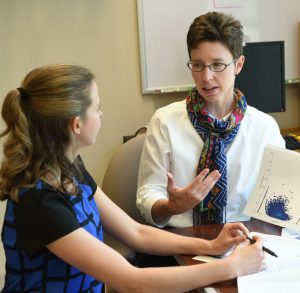Catherine Lang, P.T., Ph.D. our Spotlight Scientist talks about stroke rehabilitation research, using video publication to communicate with clinicians and the future of wearable sensor-based research.
 Cathering Lang, Ph.D. (Photo Credit: WUSM)
Cathering Lang, Ph.D. (Photo Credit: WUSM)
Catherine Lang, P.T., Ph.D. is the Associate Director of Movement Science Program and Professor at the Washington University School of Medicine (WUSM) in St. Louis. She recently published a JoVE Video Article highlighting methodology to quantify upper limb performance in stroke patients using wearable sensors.
JoVE caught up with Dr. Lang to get some insight into stroke rehabilitation research and learn about the future of wearable sensor-based research.
Q. What is your overall research focus?
A. Our goal is to improve rehabilitation for people that deal with the disabling consequences of stroke. Stroke is a brain injury that kills neurons; leaving people with motor, cognitive, and language deficits that we don't currently have a cure for. We’re particularly interested in improving the loss of motor function after stroke.
Q. Please tell us a bit more about the research you recently published in JoVE.
A. A key goal of rehabilitation services for people with stroke and other neurological conditions is to improve one's ability to function in daily life. What we highlight in our JoVE Video Article is we're interested in how people are doing when they're not in the clinic or rehab facility. We used wearable sensors to track and measure the arm movements of patients when they weren’t with us in the clinic.
We studied stroke victims that were six months or more post stroke. Although they improved their capabilities in front of us, we discovered that these gains did not translate over once the patient returned home. That really makes us rethink how we're delivering therapy, to specific people. That's a problem.
 Q. What made you decide to publish this research in a video format? Who do you think will benefit from your JoVE video?
Q. What made you decide to publish this research in a video format? Who do you think will benefit from your JoVE video?
Nowadays, busy clinicians don't have time to read lengthy text material. Video makes our research more accessible for clinical researchers and people that are making decisions about treating patients. If they can watch a six or seven-minute video and say, "Oh, I never thought about this before," or "Oh, maybe I should try this." I think that would be a really wonderful thing.
My vision would be to see the wearable-sensor approach we published, be applied in general clinical practice. This will help clinicians have access to more accurate information about patients’ improvements during therapy.
Q. What is the future of wearable sensor-based research?
A. Body sensors are ubiquitous, clever, and changing so fast that researchers are going to be confronted with an enormous amount of data. The big challenge is going to be identifying what pieces, parts, or patterns in that data are actually usable and indicative of trends. That is not a trivial problem.
 Dr. Lang talking with a participant and a student during a testing session to measure hand and arm movement (Photo Credit: WUSM)
Dr. Lang talking with a participant and a student during a testing session to measure hand and arm movement (Photo Credit: WUSM)
Q. Is there any overarching challenge in your field of research?
A. Stroke-research typically takes place at an academic institution, which may or may not be connected to the different hospitals or other and locations where people get rehabilitative care. With all the information that is available, we could build a fuller, holistic picture of stroke victims’ lives if we had a less fragmented healthcare system or a better medical record system for routine care.
The universal challenge with biomedical research is that we have a great deal of fantastic basic science that comes from the preclinical models (e.g. rodents). Those are often younger, healthy, animals. Then we try to apply those findings to the heterogeneous population of human beings living in a social and psychological environment with a host of other conditions. There are so many additional factors outside of the biological system that makes neuroscience research a challenge.
 Dr. Lang mentoring a Ph.D. student in her lab (Photo Credit: WUSM)
Dr. Lang mentoring a Ph.D. student in her lab (Photo Credit: WUSM)
Q. What message would you like to give out to other aspiring scientists or clinical researchers who are interested in your field?
A. To be successful, you have to constantly interact with people who come from a variety of perspectives, educational and professional backgrounds, and who are willing to challenge you and your ideas. That's probably true of all science, by the way.
None of the problems that we address these days in biomedical sciences have an easy solution: all of them require a great variety of expertise. The days of one investigator being able to figure everything out, are gone.
Calling out to past JoVE authors! If you have a story to share about how your JoVE publication has had a positive impact on teaching, training, collaborations, or advancing your research, then let us know , and we will reach out to you.

